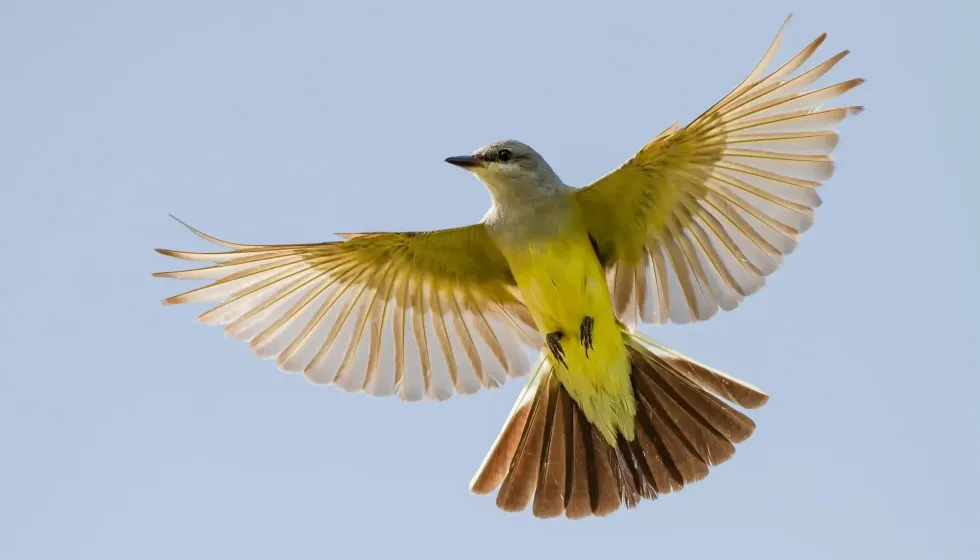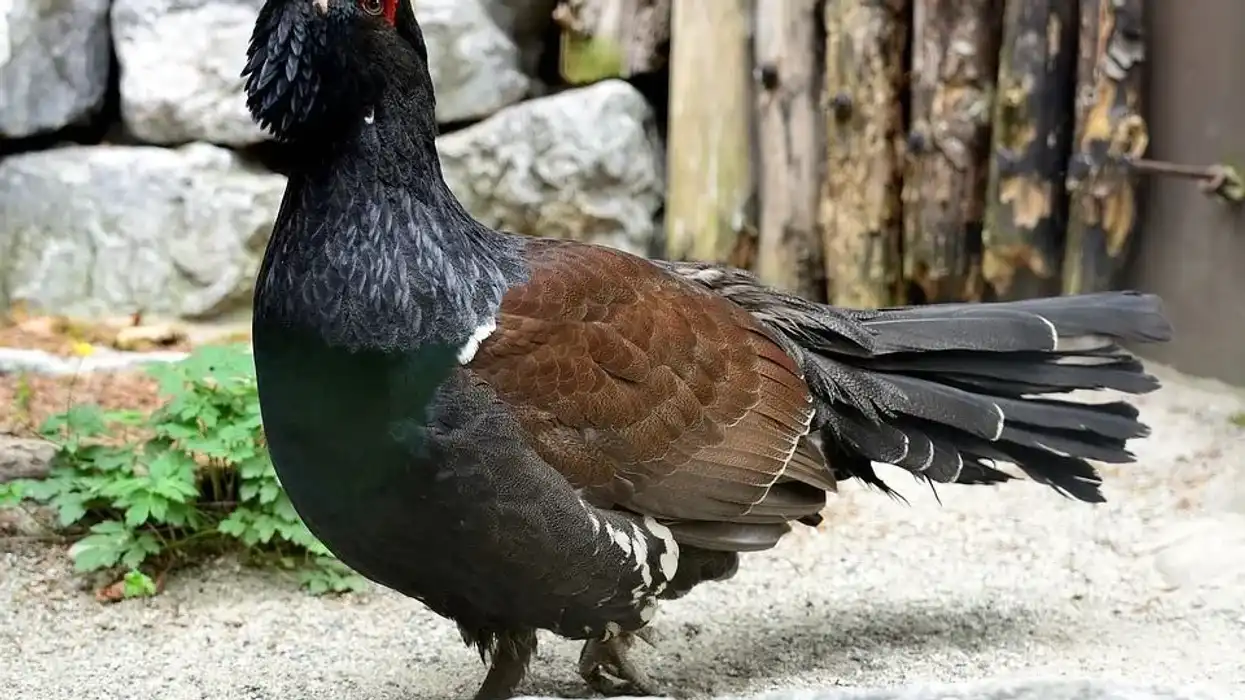Western kingbird (Tyrannus verticalis) is one of the most familiar summertime birds. They are one of the biggest tyrant flycatchers that have a large head with accompanying broad shoulders.
These gray headed birds have straight bills with long wings and square-tipped tails that are black in color.
These birds are also one of the largest distance migrators characterized by the yellow belly, white chest and throat, and black square tail with white outer lining. Western kingbirds are also popularly known as insect controllers as they feed upon a variety of insects.
These North American birds make use of man-made structures for nesting and perching. While flying, the western kingbirds look absolutely majestic.
After reading these interesting facts about these birds of western North America, do read our other articles on sanderling and house finch.
Western Kingbird Interesting Facts
What type of animal is a western kingbird?
A Western kingbird (Tyrannus verticalis) is a species of bird that is scientifically called the Tyrannus verticalis. It belongs to the family of tyrannidae and is amongst the large tyrant flycatchers found in areas of North America especially.
What class of animal does a western kingbird belong to?
Western kingbirds belong to the class of aves and are known to lay around two to seven eggs at once. The preferred western kingbird nest sites are man-made structures.
How many western kingbirds are there in the world?
It is almost impossible to find out the total number of western kingbirds, as they are located all around the world. Being one of the largest flycatchers from the tyrannidae family, they are known to have nineteen other members in their family.
These birds of North America are known to migrate to different places and are placed under the category of Least Concern as there is no potential threat to their existence.
Where does a western kingbird live?
Western kingbirds are usually found in western North American regions. They are usually known to prefer open areas with trees and utility poles that can be used for building their nest in order to lay eggs. They are also abundantly found in areas around ranch buildings and corrals that offer plentiful perches.
These birds of North America are found in Canada, United States, Mexico, Mississippi and Illinois. These large headed birds are found in southern Florida during the winter and on the west of the Pacific coast.
If you wish to view the western kingbird in flight in all their glory, then it can be easily done with the help of a bird guide, range map, and field guide.
What is a western kingbird's habitat?
Western kingbirds are one of the most widely spread birds, they are also known to migrate in different seasons.
They are well-adapted birds that have developed over the years and have even recently widened their range to both east and west of their previous habitat. They are very commonly seen in North America and are also known to be found in open habitats that have utility poles, fences, and scattered trees for them to make their nest.
A few of these birds stray eastward every fall, and appear along the Atlantic Coast.
Any bird guide will tell you that western kingbirds prefer open areas such as open country, grasslands, dry savannas, valleys, lowlands, open farms, woodlands, agricultural fields, and also sagebrush. These large headed birds are usually found in areas that have a high elevation.
Who do western kingbirds live with?
Western kingbirds are one of the biggest members of tyrant flycatchers. They are very territorial and are known for their aggressive behavior while defending their territories, even against large birds such as hawks.
These nesting birds usually travel in groups or flocks while migrating to Florida, Mexico and Central America as soon as the summer ends. Western kingbirds are usually found in small groups or pairs, especially during winter.
How long does a western kingbird live?
Not much information is disclosed and available regarding the lifespan of western kingbirds. These nesting birds are usually believed to have a lifespan of six years at maximum. This is still being researched to date.
How do they reproduce?
Western kingbirds are monogamous creatures that complete their breeding in a pair. The breeding takes place in open country with scattered trees. These flycatchers are usually known to mate in late May to early June. They have a clutch size of around four eggs but can lay around three to six eggs at once in their nests.
What is their conservation status?
Western kingbirds are among the nineteen other species of birds in the tyrannidae family that is completely conserved and is listed under the category of Least Concern by IUCN. This flycatcher species is nowhere near the scope of being endangered in the present or near-future times.
Western Kingbird Fun Facts
What do western kingbirds look like?
Western kingbirds are one of the biggest members of tyrant flycatchers that are usually gray and yellow in color. They also have bright yellow color tail feathers and belly.
The male and female species of western kingbird are usually similar looking, whereas the young ones are a lot paler than the older ones.
How cute are they?
Western kingbirds are really big members of the tyrannidae family. This flycatcher species are really cute and beautiful birds to look at.
How do they communicate?
These birds are known for their high-pitched voice that sounds similar to the squeaky song "pidik pik pidik PEEKado". Western kingbirds also use varied rapid calls that sound like "widik pik widi pik pik".
They are known to have kit calls that are harsh and are usually used by males while safeguarding themselves as well as their territory. These kingbirds are also known to communicate with one another through fluttering or flicking their wings, crouching and fluffing their crown feathers.
How big is a western kingbird?
Western kingbirds are amongst the biggest members of their family. Western kingbird length is an average of 7.9-9.4 in (20-23 cm). This flycatcher species is larger than the black phoebe and smaller than American robins.
How fast can a western kingbird fly?
While not much is known in regards to an exact estimation of their speed, when they spot their prey these birds increase their windspeed and rush to catch them.
How much does a western kingbird weigh?
Western kingbirds weigh around 0.08-0.1 lb (1.3-1.6 oz).
What are the male and female names of the species?
Similar to many other birds and creatures, there is no specific name given to the male and female species of western kingbird. They are commonly regarded as male western kingbird and female western kingbird.
What would you call a baby western kingbird?
The babies or young ones of western kingbirds have not been given any specific name. They are generally regarded as baby western kingbirds’ who are born from eggs and have their eyes closed for some days after birth.
What do they eat?
Most of their diet is filled with both flying and crawling insects. This flycatcher species eats a variety of insects including winged ants, robber flies, bees and grasshoppers but they are also known to eat berries, fruits, spiders and seeds.
Are they dangerous?
Western kingbirds are considered no threat to humans and are usually not considered dangerous. But in their natural habitat, they are really aggressive and are known to chase and scold intruders that try to threaten, prey, or interfere with their territory.
Would they make a good pet?
Western kingbirds are usually big-sized birds that are not the top choices of pet owners. Kingbirds are rarely kept as pets as they are known to display aggressive behavior regarding their territory. They are not suited as pets as they need to migrate in order to survive and reproduce.
Did you know...
Western kingbirds are medium to long-distance migrants that travel south at the end of summer. These birds are known to start forming their nest around May they make these nests using twigs, grass, and weeds lined with cotton or hair.
Western kingbirds lay around three to six eggs at once. These kingbirds are known to produce around one to two broods per year.
How to tell apart Cassin's and western kingbird?
More often than not, western kingbirds are often confused with Cassin's kingbird. But when you compare Cassin's kingbird vs western kingbird, you will realize that even though they are both very similar-looking birds, they can be easily differentiated through the following points: Cassin’s have a white malar stripe on their dark grey wings, whereas western kingbirds don't.
Western kingbird song and western kingbird calls are completely different from Cassin's kingbird.
What does a western kingbird sound like?
Western kingbirds are one of the most vocal members of their family. They have the ability to make really sharp sounds that are also called the kip notes, along with making squeaky twitters. The male western kingbirds are very territorial and make harsh buzzing calls when attacking predators or other kingbirds.
Here at Kidadl, we have carefully created lots of interesting family-friendly animal facts for everyone to discover! Learn more about some other birds including california quail, or monk parakeet.
You can even occupy yourself at home by drawing one of our western kingbird coloring pages.










